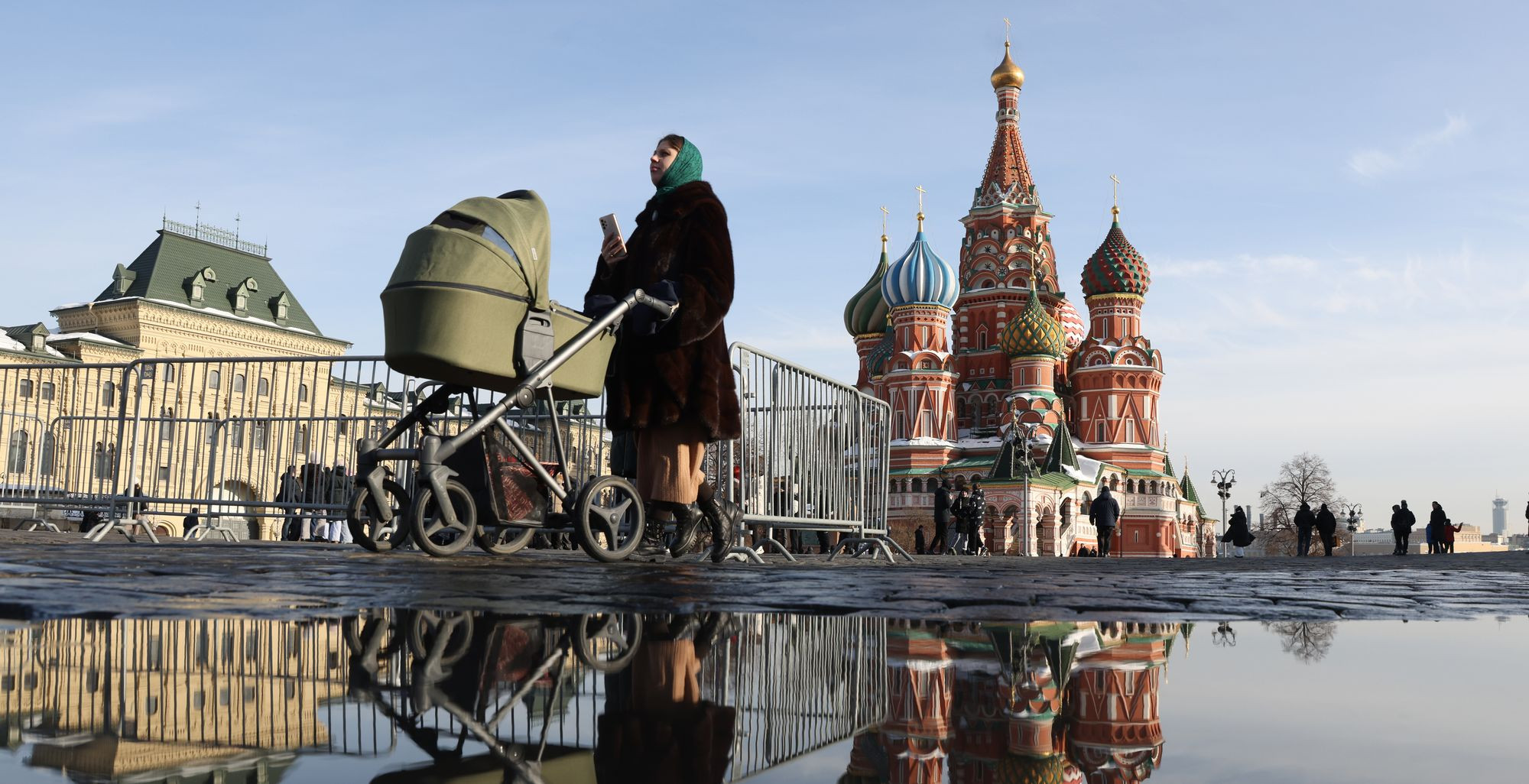Russian President Vladimir Putin often portrays himself as the guardian of global stability, leading a powerful nation that offers economic, military, and cultural alternatives to the West. However, his vision is facing a significant challenge.
Russian President Vladimir Putin at the Kremlin on March 12. Photo: AFP

Russia's population has been declining for years, and the prolonged, costly war in Ukraine has worsened the situation. Moscow does not release casualty figures, but Western estimates suggest that at least 150,000 Russian soldiers have died in the Ukraine conflict. The war has not only caused loss of life but also led nearly a million Russians, mostly men, to leave the country to avoid a partial mobilization order issued by President Putin. The birth rate is at its lowest in over two decades, with some regions near the conflict zone experiencing sharper declines than the national average.
President Putin has described increasing the birth rate as a national priority. He has declared 2024 as the "Year of the Family" and introduced subsidies for families with three or more children, allocating up to $157 billion for family and child support measures over the next six years. He emphasized that Russian society itself needs to change, with larger families becoming more common. "Motherhood is a woman's highest calling," President Putin said in a speech on International Women's Day in March. "Family is the most important thing for every woman, regardless of her career path or professional achievements."
A poster at a bus stop advertising a helpline for expectant mothers in St. Petersburg in 2023. Photo: AP

Russia's most significant population increase in recent years occurred when it annexed Crimea in 2014, adding about 2.4 million people to its population. According to Nicholas Eberstadt, a political economist at the American Enterprise Institute in Washington, the population decline, especially among working-age individuals, and the brain drain are creating a demographic crisis for Russia. "Losing that human capital will harm Russia's economic future," he said. "Demographics are indeed a very urgent issue," Kremlin spokesman Dmitry Peskov acknowledged. "Measures to increase the birth rate are a top priority for the government and the President. Most of the country's development strategies are aimed at this goal." He noted that the primary cause of the problem is the declining birth rate. During World War II and the dissolution of the Soviet Union in the 1990s, Russia faced significant challenges. Despite these, the government had some success with programs aimed at boosting birth rates. The Soviet Union once had the third-largest population in the world. However, after its collapse, economic and social upheavals led to increased deaths from diseases, traffic accidents, suicides, and other causes, often linked to alcohol consumption. Russian women also began having fewer children. By 2003, the average life expectancy in Russia had dropped from 69 years in 1990 to about 65 years, significantly lower than many Western countries at the time.
According to United Nations data, Russia's economy has stabilized, and policies restricting alcohol sales and anti-smoking campaigns have helped raise the average life expectancy to around 70 years by 2022. However, this is still lower than most developed countries. For instance, the United States has an average life expectancy of about 78 years, and Estonia, a former Soviet republic, has an average of 79 years. When the Covid-19 pandemic struck, Russia was one of the hardest-hit countries globally. Demographer Alexey Raksha, who was dismissed by the Russian government in 2020 for revealing incomplete Covid-19 statistics, reported that from April 2020 to March 2022, approximately 1.12 million Russians died due to Covid-19 and its health consequences. This death toll is comparable to that of the United States, even though Russia's population is less than half that of the U.S.
As of now, Russia has about 146 million people, ranking ninth globally, according to United Nations data. This number is still much larger than Ukraine's pre-war population of around 44 million, which faces similar demographic challenges. Experts note that unlike many Western countries, Russia does not attract enough immigrants to offset its aging population and declining birth rate. Russia's population, like that of Japan and some other nations, is expected to continue decreasing for the rest of this century.
The population issue has been exacerbated by the ongoing conflict. According to Re: Russia, a research and analysis group, about 920,000 Russian citizens had left the country by July 2023 due to migration data calculations. While some have returned, many who have settled abroad are skilled professionals in fields like information technology and other critical areas. This exodus further strains Russia's demographic situation.
In summary, Russia's demographic crisis is deepening due to a combination of low birth rates, high mortality rates, and significant emigration. The government's efforts to stabilize the population through economic measures and public health campaigns have had some success, but the challenges remain substantial. The ongoing conflict and the resulting brain drain only add to the urgency of addressing these demographic issues. The future of Russia's population growth and economic stability will depend on the effectiveness of these measures and the country's ability to adapt to its changing demographic landscape. The number of migrants in 2022 was about 668,000, the highest since 1992, and around 450,000 in 2023. The most obvious consequence is a labor shortage to meet the demands of the battlefield. President Putin has redirected much of the economy towards boosting military production. Last year, he mentioned that the lack of skilled workers was hindering this effort. About 47% of manufacturing companies reported labor shortages in January, the highest since 1996, according to a survey by the Gaidar Institute for Economic Policy in Russia. The Russian Academy of Sciences estimated last December that the country is short of 4.8 million workers. The Central Bank of Russia noted that the labor shortage is particularly severe in manufacturing, transportation, logistics, and construction sectors. Russian demographers worry that the conflict could once again lead to so-called "deaths of despair" from alcohol-related diseases and other causes. Alcohol and drugs have long been a problem in Russia. In a televised meeting in 2022, President Putin told the mother of a soldier killed in Ukraine that dying on the battlefield is more honorable than dying from alcohol addiction. "For some people, it's unclear whether they are alive or not. It's unclear why they died, whether from vodka or something else. But your son achieved his goal," he said. Whether Russia can solve its population problem will depend on the length and scale of the conflict, observers say. Tatiana Mikhailova, an associate professor of economics at Pennsylvania State University, USA, noted that President Putin's significant investment in weapons production has created many jobs and helped raise wages, but this boost could impact future economic growth and "any decline in living standards will affect the birth rate." According to government statistics, about 1.26 million children were born in Russia in 2023, the lowest in over two decades. Raksha, a national and regional data analyst, estimated that Russia's total fertility rate, the number of children each woman has in her lifetime, has remained unchanged since 2022. Russia's past crises continue to affect generations. Raksha noted that the population decline after the Soviet Union's collapse means there are fewer women of childbearing age today.The number of women of childbearing age is expected to drop by 40% by 2030 compared to 2010. Economic concerns are a major factor influencing Maria's decision about having more children. Maria, a 34-year-old lawyer in Novosibirsk, Siberia, already has a 6-year-old son. "I really want a second child," she said. But rising prices and stagnant real incomes are a problem. She recently calculated that prenatal screenings cost about $890. "There is no stability, no confidence in the future to calmly plan for more children, even though I really want to be a mother again," she said. Nationwide, births have continued to decline this year, dropping 3.5% from January to March compared to the same period last year. According to Rosstat, Belgorod province, which borders Ukraine and is affected by conflict, saw a 10.2% drop in births. Other regions bordering Ukraine and Crimea also experienced higher-than-average declines. Bryansk, which has faced drone attacks from Ukraine on oil facilities, saw an 8.2% decrease. Russian demographer Igor Efremov noted that in some provinces, birth rates are falling faster due to the mobilization of hundreds of thousands of young men for the battlefield since September 2022. Data collected by FilterLabs.AI, a U.S.-based company analyzing news sites, local websites, online forums, and group messaging apps in various countries, shows that attitudes toward having children in Russia have changed. "Throughout 2023, we noticed more people talking about delaying starting a family," said Jonathan Teubner, the company's CEO. At the request of authorities, private clinics in some areas, including Crimea, have stopped performing abortions. The Russian Duma is considering a nationwide ban on abortions in private clinics. President Putin called abortion an "urgent issue." However, "women's rights and freedoms must also be respected," he said in December 2023, suggesting that a ban could backfire. Russian Senator Margarita Pavlova last year proposed that the government should encourage young women to have children instead of pursuing higher education. "Perhaps all the...Officials recognize that we are on the brink of a demographic winter," she said. Salavat Abylkalikov understands Russia's population issues better than most. The 37-year-old demographer noted that problems like declining birth rates, low immigration, and reduced life expectancy, which Russia faced before, will worsen due to the conflict. He also sees it in his own life. Abylkalikov's 33-year-old wife became pregnant in mid-February 2022, just before Russia launched its military actions in Ukraine. At that time, despite some uncertainties, they felt that "life seemed to be getting better," he said. When the fighting began, they decided to leave Russia as soon as their daughter was born. His daughter Diana is now a year and a half old, and the family moved to the UK last year. He and his wife are considering having a second child abroad, "but only when we are completely confident about our future," Abylkalikov emphasized.
Photo: WSJ

Dieter Roark (According to WSJ, Reuters, AFP).



















0 Comments